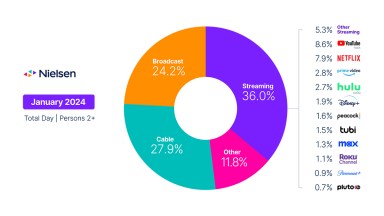With the convenience and personalized benefits offered by on-demand program viewing, it’s no surprise that VOD is fast becoming a part of daily viewing habits for many around the world, regardless of age. In fact, among the 65% of global respondents who watch any type of VOD programming – which can include long- and short-form content – more than four-in-10 say they watch at least once a day (43%).
And it’s not just the youngest respondents viewing on-demand programming. While a higher percentage of Generation Z (aged 15–20) and Millennial (aged 21–34) respondents report watching on-demand content daily or more often (49% and 48%, respectively) than their older counterparts, more than one-fifth (21%) of Silent Generation respondents (aged 65+) and one-quarter (26%) of Baby Boomers (aged 50-64) say they watch at least once a day. Generation X respondents (aged 35-49) fall in the middle, both age-wise and in self-reported on-demand viewing, with 38% saying they view daily.
Movies dominate the type of VOD content watched across all regions and generations. Eighty percent of global respondents who watch on-demand content say they view movies, followed by on-demand TV programs (50%). When it comes to popular program genres, comedies (38%) and original series (32%) rank the highest globally, followed by sports and documentaries (31% each). Twenty-two percent of global respondents say they watch short-form video content (videos of 15 minutes or less in length).
So what does the current cross-generational popularity of VOD viewing mean for future viewing patterns? A look at willingness to pay for programming options by generation provides some insight.
A majority of respondents across all age groups say they pay to watch broadcast or video programming via a cable and/or satellite service. Globally, 70% of Gen Z and 73% of Millennial respondents say they pay this type of traditional provider for content, compared with 77% of Gen X, 64% of Baby Boomer and 63% of Silent Generation respondents. Online-service subscriptions (such as Hulu, Netflix and Amazon), however, skew younger. In fact, 31% each of Gen Z and Millennial respondents say they pay an online-service provider for content. The figures are lower among older respondents, as 24% of Gen X, 15% of Baby Boomer and 6% of Silent Gen respondents say they pay an online service provider for content.
“The increasing popularity of online-only video services will continue to put pressure on networks and MVPDs, but a substantial replacement of one for the other is unlikely,” said Megan Clarken, president, Nielsen Product Leadership. “While some consumers are cutting back on traditional TV services, many aren’t severing the cord completely. For most viewers, online and traditional services are not mutually exclusive, but complementary. Moreover, online-only services, networks and MVPDs face many of the same challenges, including rapidly evolving consumer preferences, an overabundance of choice and rising content costs. In the near term, cord shaving is likely the biggest threat as consumers evaluate the benefit of premium services or networks and consider slimmer channel packages that provide a better match for both preferences and wallets.”
Other findings from the global Video-on-Demand report include:
- Nearly two-thirds of global respondents (65%) say they watch some form of VOD programming, which includes long-and short-form content.
- More than half of global respondents (59%) say they don’t mind getting advertising if they can view free content.
- 在观看视频点播节目的全球受访者中,超过四分之三(77%)的受访者认为,他们这样做是因为可以在方便的时间观看。
- 在观看视频点播节目的受访者中,"千禧一代 "和 "X 代 "受访者最有可能同意他们喜欢同时追看多集节目。
For more detail and insight, download Nielsen’s Global Video-on-Demand report. If you would like more detailed country-level data from this survey, it is available for sale in the Nielsen Store.
关于尼尔森全球调查
The Nielsen Global Video-on-Demand Survey was conducted Aug. 10-Sep. 4, 2015, and polled more than 30,000 online consumers in 61 countries throughout Asia-Pacific, Europe, Latin America, the Middle East/Africa and North America. The sample includes Internet users who agreed to participate in this survey and has quotas based on age and sex for each country. It is weighted to be representative of Internet consumers by country. Because the sample is based on those who agreed to participate, no estimates of theoretical sampling error can be calculated. However, a probability sample of equivalent size would have a margin of error of ±0.6% at the global level. This Nielsen survey is based only on the behavior of respondents with online access. Internet penetration rates vary by country. Nielsen uses a minimum reporting standard of 60% Internet penetration or an online population of 10 million for survey inclusion.




